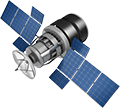Toward a society where everyone around
the world is connected
We are up for the challenge
The Internet has changed our lives dramatically for the better.
Still, many people in the world have no access to the internet.
In areas where the communication environment is not well developed,
businesses and industries are lagging with digital technologies
and their problems remain unresolved.
SoftBank is taking to the sky
to create a society where anyone can connect to the Internet, from anywhere.
SoftBank's NTN Solutions
Non-terrestrial networks (NTN) deliver telecommunication connectivity from space and the stratosphere. SoftBank has three different NTN solutions: OneWeb, Starlink Business and HAPS (High Altitude Platform Station).
OneWeb delivers high-throughput, low-latency satellite communication service with a bandwidth guarantee. Starlink Business, meanwhile, delivers high-speed, low-latency satellite Internet service. HAPS flies in the stratosphere at an altitude of 20 km and delivers connectivity directly to smartphones.
Due to the different characteristics in terms of throughput and communication protocols, we propose appropriate solutions based on user applications and will promote their deployment in Japan and globally.
High-speed, high-capacity satellite communications service
OneWeb operates its communication services with its low Earth orbit (LEO) constellation consisting of satellites at an altitude of 1,200 km. Placing large numbers of satellites in low Earth orbits that are closer to Earth than traditional geostationary satellites enables the service to offer high-throughput communication service with low-latency. We will also provide a bandwidth guarantee service to ensure that customers get the speed and stability they expect.

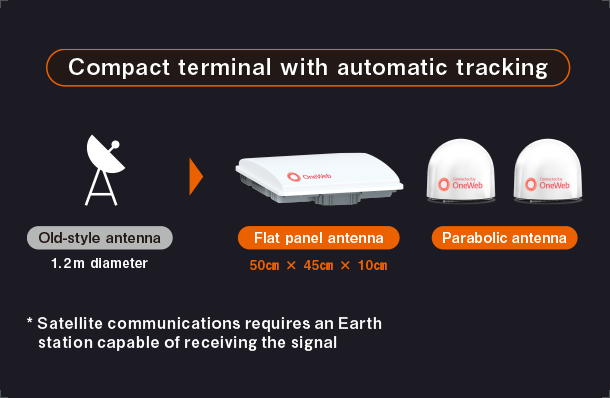
Space-saving Antennas
For user terminals, in addition to parabolic antennas suitable for high-throughput communication, we will make small electronic flat antennas available to our customers. These antennas can be installed in a space-efficient manner, allowing for a smaller footprint compared to conventional setups.
High-throughput communication service with low latency
The communication service provided by OneWeb’s low Earth orbit satellites is able to offer speeds of up to 195 Mbps (downlink) and 32 Mbps (uplink) The latency is approximately one-tenth of that of geostationary satellites, ensuring low-latency communication. Using satellite as a backhaul, it is also possible to expand mobile communication coverage.
[Note]
-
*
The services to be provided by OneWeb are still under consideration and are subject to change.
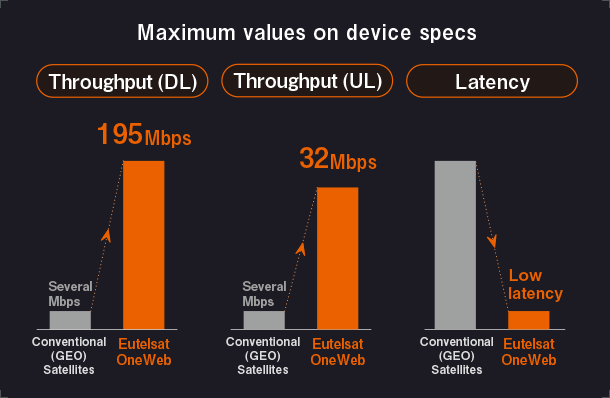

Assumed Use Cases
Sea vessels

- Providing broadband communication service for sea vessels in areas where terrestrial base station signals are not reachable, offering high-throughput and real-time communication service required for future autonomous navigation systems.
Construction

- Providing communication service in out-of-coverage areas at construction sites, enabling remote monitoring of worksites and remote control of construction machinery to achieve digitalization of construction sites.
Disaster recovery

- Providing communication service for local governments, infrastructure operators, and enterprises in case of network outages during disasters.
Forestry
(Mountainous areas)

- Enabling digital transformation (DX) of forest resource and afforestation management, improving work efficiency through the tracking of worker locations, monitoring forest fires and illegal logging from distant locations, remote operation of heavy machinery and providing communication service for workers.
Remote area infrastructure

- Providing inspection of power grid facilities and system stability, remote monitoring of the deterioration status of structures such as dams, levees, and ports. Enhancing productivity through DX.
OneWeb
OneWeb was established to pursue the vision of using its own satellite network to eliminate the digital divide. Following its acquisition by the UK government and Bharti Group in November 2020, further investment was provided by SoftBank Group, Eutelsat, Hughes Network Systems, and Hanwha Systems in 2021. In May 2021, SoftBank Corp. and OneWeb entered a business partnership, and they are currently working to roll out the service in Japan and globally.
Providing high-speed and low-latency data communication
Starlink Business offers a high-speed, low-latency satellite Internet connectivity service (up to 220 Mbps (downlink) and up to 25 Mbps (uplink)*) via satellites in low Earth orbit at an altitude of 550km.
[Note]
-
*
Data communication is provided on a best effort basis, so actual data transmission speeds may vary. Communication may be interrupted due to weather conditions such as rain and snow.
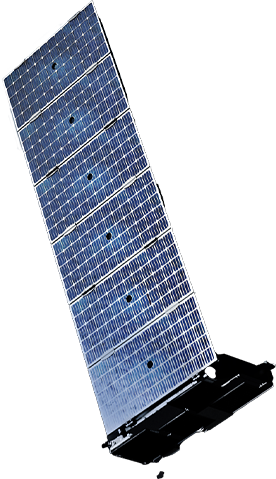

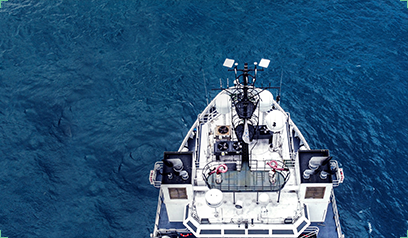
Compatible with smartphones
HAPS, High Altitude Platform Stations, provide communication services from uncrewed aircraft hovering in the stratosphere at an altitude of 20 km. HAPS-based communication services offered do not require specialized dedicated devices like satellite communications do. Since they use the same frequencies as those used on the ground, it allows direct communication to smartphones.

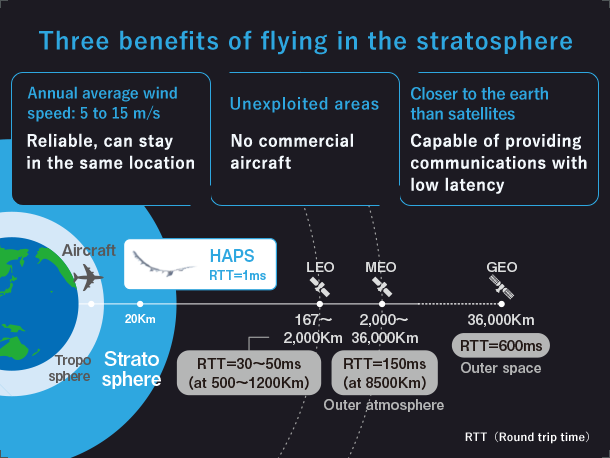
Utilizing the stratosphere for stable communications
The stratosphere, situated at a significantly higher altitude than where commercial aviation flies, remains an untapped region for communication services. Thanks to the relatively gentle winds, aircraft can circle within a designated area, enabling the provision of a stable communication service. Operating at an altitude of 20 km, a single HAPS aircraft can cover approximately 200 km in diameter, greatly surpassing the coverage of ground base stations.
Assumed Use Cases
Coverage area expansion
- Providing communication services to mountainous regions, islands or other remote areas where terrestrial communication networks are not deployed.
Disaster recovery
- Deploying aircraft over affected areas enables the temporary restoration of communication coverage in case of network outages during disasters such as earthquakes or tsunamis.
Network for IoT
- Creating a three-dimensional network, including in mid-air, enables the provision of communication services for IoT devices like drones, which are expected to become more widespread in the future.





